 |
Consequences of Vatican II
Jewish Influence Grows in the Conciliar Church
Lyle J. Arnold, Jr.
Following the release of Pope Ratzinger's Jesus of Nazareth Part II, progressivists, conservatives and traditionalists have raised their voices to either rejoice at or reject his assertion that the Jews need not convert. From a formerly anti-progressivist paper, we were surprised to read a tacit approval of Benedict’s opinion (The Remnant , March 15-31, 2011).
The error that the Jews need not convert has become old hat since Vatican II and has been taught by the post-Conciliar Popes for some decades now. This segued into a platform that affirms proselytism of anyone is no longer a duty of the Church.
As A.S. Guimaraes points out in Animus Delendi II: “Few things can be more expressive of the progressivist intent to do away with militancy and the missionary character of the Church than the affirmation that heretics do not need to be converted”. (1)
The five conciliar and post-conciliar Popes have professed and preached several heresies such as universal salvation. But one can note in particular a specific approval of Judaism and the attempt to adapt Catholic doctrine to its errors.
Accords prior to Vatican II
The Pope's decision to collaborate with the Jews began in earnest in the 1960s. Confirmation of this is found in the January 25, 1966 issue of Look magazine in an article titled “How the Jews Changed Catholic Thinking.”
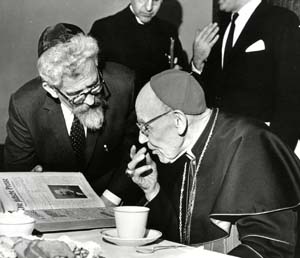
Card. Bea confers with Rabbi Heschel at the Council |
The article, bylined by senior editor Joseph Roddy, reported secret negotiations held in New York and Rome in the 1960s between Cardinal Bea with the leaders of world Jewish organizations, such as B'nai B'rith, the American Jewish Committee and others. (2)
Roddy quotes liberally from the works of Jules Isaac, a French Jew and rabidly anti-Catholic historian, who calls the Evangelists liars, St. John Chrysostom a delirious theologian, St. Augustine a falsifier of facts and Pope St. Gregory the Great the inventor of “the formidable theme of the carnal people, which has unleashed the savagery of the Beast against the Jews throughout history.” Isaac especially hated St. Matthew, to whom he awards “the palm” for making the Jews appear most hateful. (3)
Thus, based on Isaac, Roddy implies that it was the Church who fostered anti-Semitism throughout her history.
It was Isaac, in fact, who intervened with Pius XII to revise the Good Friday prayer, which previously contained what he called “offensive references to the Jews.” Later, at Vatican II, he played an important role in the conciliar document Nostra aetate. So powerful was his influence on that document that the Archbishop of Aix stated: “It is a sign of the times that a layman – and a Jewish layman at that – has become the originator of a Council decree.” (4)
Isaac’s collaboration at Vatican II resulted from a personal talk with John XXIII in June of 1960. He had written two books fiercely censuring the Catholic teaching, which he claimed was the source of modem anti-Semitism. He demanded the ‘purification' and ‘amendment' of the centuries-old Church doctrine. His basic thesis: “We must have done with anti-Semitism, the logical outcome of which was the liquidation of Jews at Auschwitz and other death camps during the Second World War.” (5)
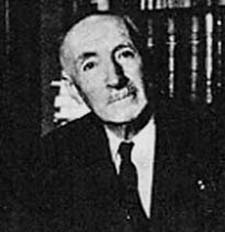
Issac helped to draft Nostra aetate |
To eliminate the so-called anti-Semitism, Isaac counted on the support of John XXIII and the upcoming Second Vatican Council. The world-wide Jewish community wanted the Council to suppress the deservedly severe language of the Church regarding the Jews and their errors, perfidy and contumacy over the past two thousand years.
Pope Rocalli gave Isaac his word that he do his best to remove from Catholic teaching anything that would provide fuel for “anti-Semitism.“ He also made it clear to the heads of the Vatican Curia that a firm condemnation of Catholic anti-Semitism was to come from the Council he had called. He chose Jesuit Card. Augustin Bea, as the best “legislative whip for the job.” (6)
The Curia warned that the Council Bishops should not touch this issue with a ten-foot pole. But John XXIII persisted, telling them they must. And so the Jewish leaders and the progressivists had their way. Section four of Nostra aetate denied the centuries-old Deicide charge against all Jews, imagined a religious bond shared by Jews and Catholics, pretended an eternal covenant between God and the Jews was still valid, and boycotted Church efforts to convert and baptize Jews.
The novelty promoted by the last Popes
We arrive at Assisi, 1986. To dramatize the novelty that not only Jews but all pagans and heretics need not convert, representatives of the world's pagan and heretical religions were corralled at Assisi by Vatican invitation to pray for peace. It was an ecumenical circus, where prayers were chanted by Buddhists, Hindus, Jainists, Muslims, Shintos, Sikhs, Amerindians, Zoroastrians. The Africans prayed to “The Great Thumb.”
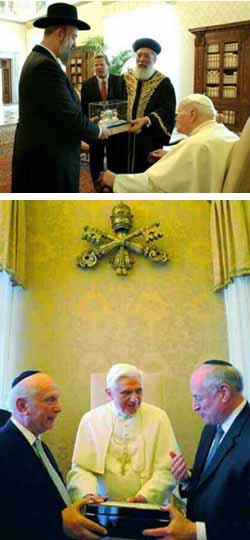
The presence of rabbis increases at the Vatican |
During a prayer session by pagans, a statue of Buddha was placed over the Tabernacle of the altar. Card. Silvio Oddi reported on this incident: “On that day I walked through Assisi and I saw real profanations in some of the places of prayer. I saw Buddhists dancing around the altar, upon which they placed Buddha in the place of Christ and then incensed it and showed it reverence. A Benedictine protested and the police took him away. There was obvious confusion in the faces of the Catholics who were assisting at the ceremony." (7)
In his work Quo Vadis, Petre?, Guimaraes comments on this abomination:
“The Old Testament relates how one of the kings, Manasses, committed the crime of placing an idol in the Temple of the Lord (4 Kg. 21: 7; 2 Par. 33:7). God punished this action with the destruction of Jerusalem by the Assyrians (4 Kg. 21: 15-15; Dan. 12: 11). Various Scripture commentators have held that this sacrilege of Manasses gave origin to the expression “the abomination of the desolation installed itself in the Holy Place,” a phrase employed in Holy Scripture. How can one not compare this event from the Old Testament with the enthronement of a statue of Buddha over the Tabernacle of a Catholic Church in Assisi?” (8)
Then, to further impose this novelty about the supposed primacy of the Jews and the “eternal covenant between God and his Jewish people,” the Pontifical Biblical Commission published The Hebrew People and its Holy Scriptures in the Christian Bible with a Preface by Card. Joseph Ratzinger (Libreria Editrice Vaticana, 2001). (9) The book deals with the interpretation of Holy Scripture. Basing itself on historicism, (10) it implicitly denies the Gospel as a source of Revelation, in order to absolve the Jews of the crime of Deicide.
In the aftermath of this book, a document made by the National Council of Synagogues and the U.S. Catholic Bishops’ Committee on Ecumenical and Inter-religious Affairs was issued (August 12, 2002). The text clearly states the new Church thinking on Jews: “Campaigns that target Jews for conversion to Christianity are no longer theologically acceptable in the Catholic Church.” (11)
We have seen the Conciliar Church traveling far from the path of the immutable Catholic teaching. The new exoneration of the Jews for the crime of Deicide, affirmed by Pope Ratzinger in his recent book, sadly fits precisely into this pattern of post-Conciliar thinking on Jews.
1. A.S. Guimaraes, Animus Delendi II, p. 283.
2. Leon de Poncins, Judaism and the Vatican – An Attempt at Spiritual Subversion (London: Britons: 1967), p. 167.
3. Ibid., p. 28.
4. Ibid, p. 167.
5. Ibid., p. 11.
6. Ibid, p. 168.
7.A.S. Guimaraes, Quo Vadis, Petre?, TIA, 1999, pp. 5-6
8. Ibid.
9. A.S. Guimaraes, Changes in Doctrine and New Anathemas, p. 28.
10. Pius XII defines historicism in this way: “The term ‘historicism' indicates a philosophical system that acknowledges change and evolution in the whole spiritual reality ... irreconcilable with the Catholic conception of the world” Speech to the International Congress of Historical Sciences, 9-7-55, in Discorsi I Radio-messagi di Sua Santita Pio XII, Editrice Vaticana, vol. 17, p. 212.
11. A.S. Guimaraes, “Conversions, From Now On, Prohibited?.”

Posted May 11, 2011

Related Topics of Interest
 The Deicide and the Council The Deicide and the Council
 Benedict’s New Book Contradicts Church Teaching on Jews Benedict’s New Book Contradicts Church Teaching on Jews
 Benedict XVI: ‘For Many’ Means “For All” Benedict XVI: ‘For Many’ Means “For All”
 Benedict XVI Visits the Cologne Synagogue Benedict XVI Visits the Cologne Synagogue
 Visiting the New York Synagogue Visiting the New York Synagogue
 Benedict Venerating Jewish Books Benedict Venerating Jewish Books
 Is the Catholic Church Becoming a Branch of the Synagogue? Is the Catholic Church Becoming a Branch of the Synagogue?
 Conversions? From Now on, Prohibited... Conversions? From Now on, Prohibited...

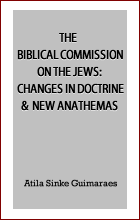 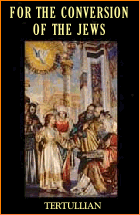 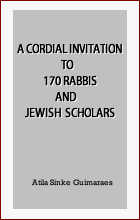

|
Vatican II | Hot Topics | Home | Books | CDs | Search | Contact Us | Donate

© 2002-
Tradition in Action, Inc. All Rights Reserved
|
 |
|